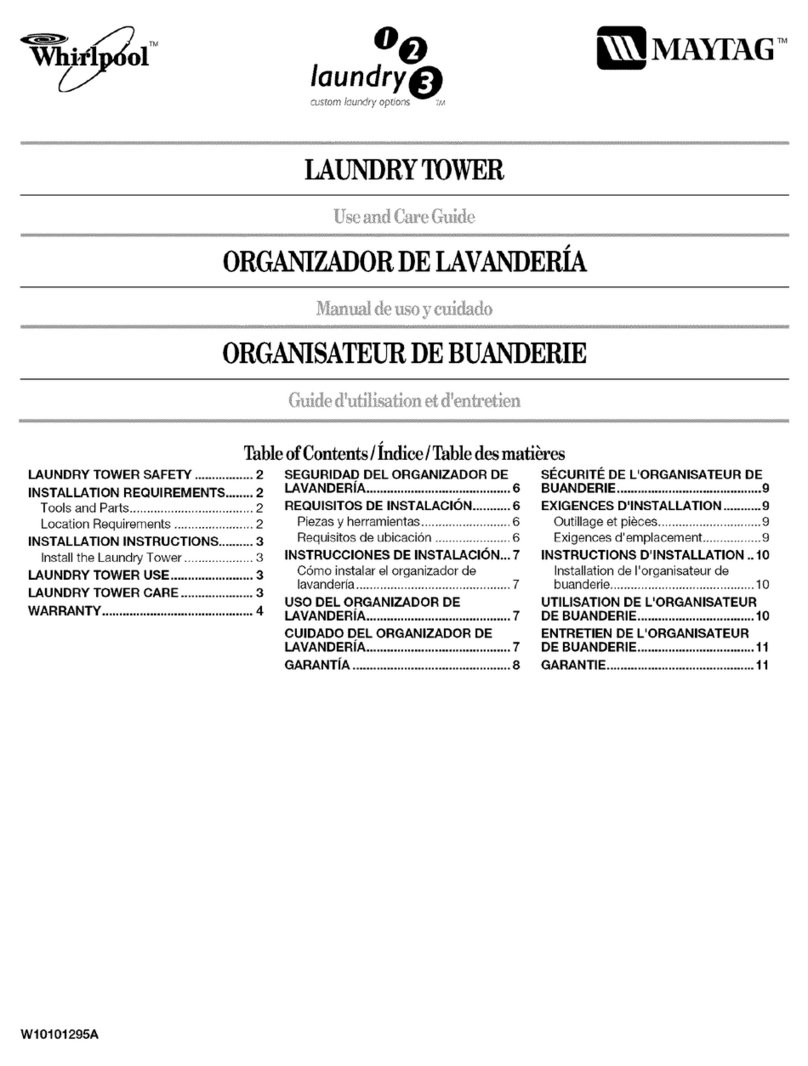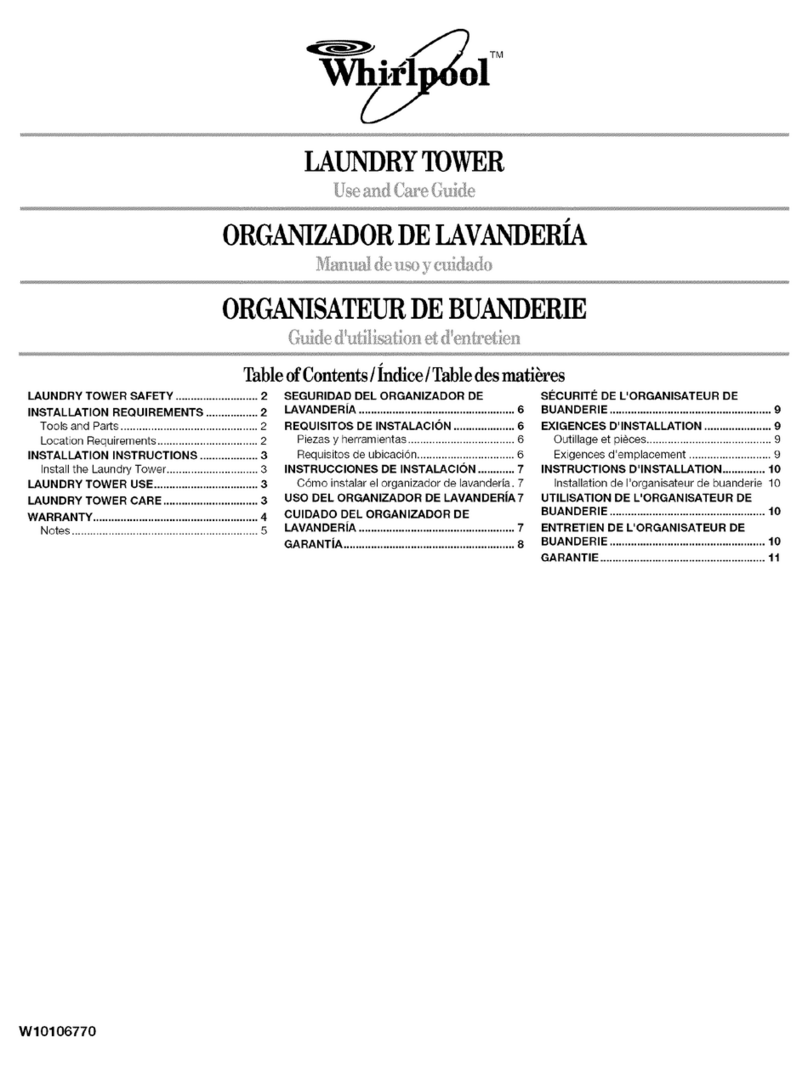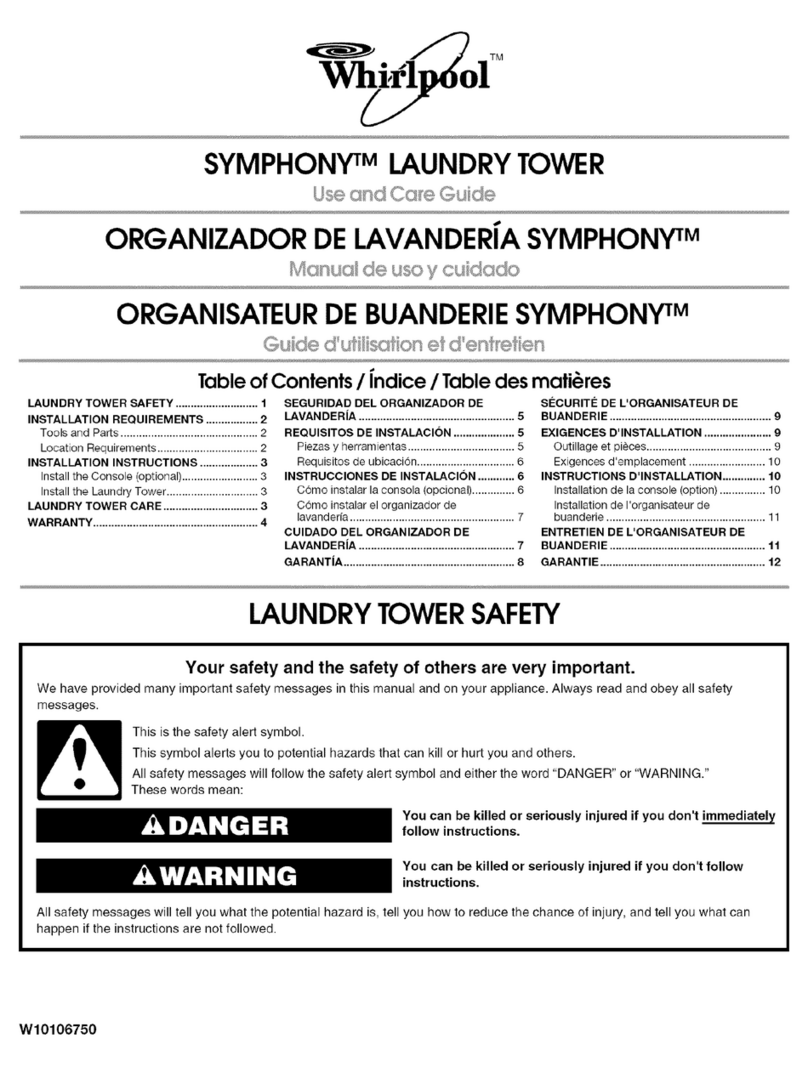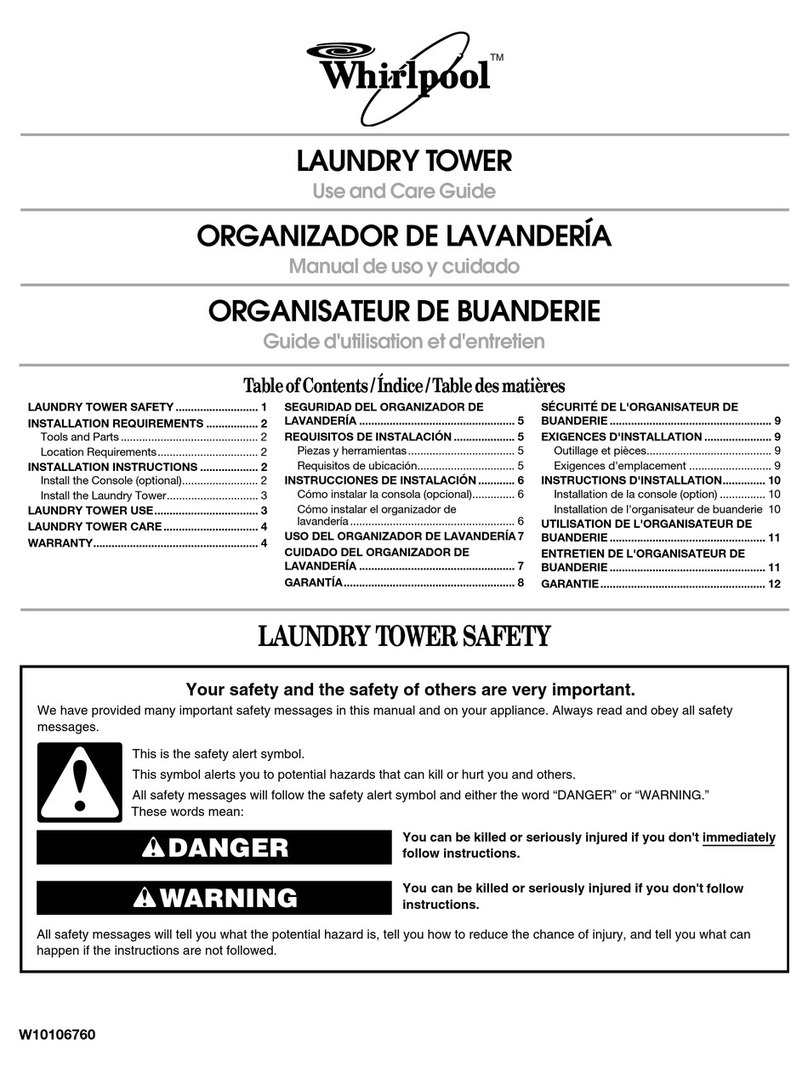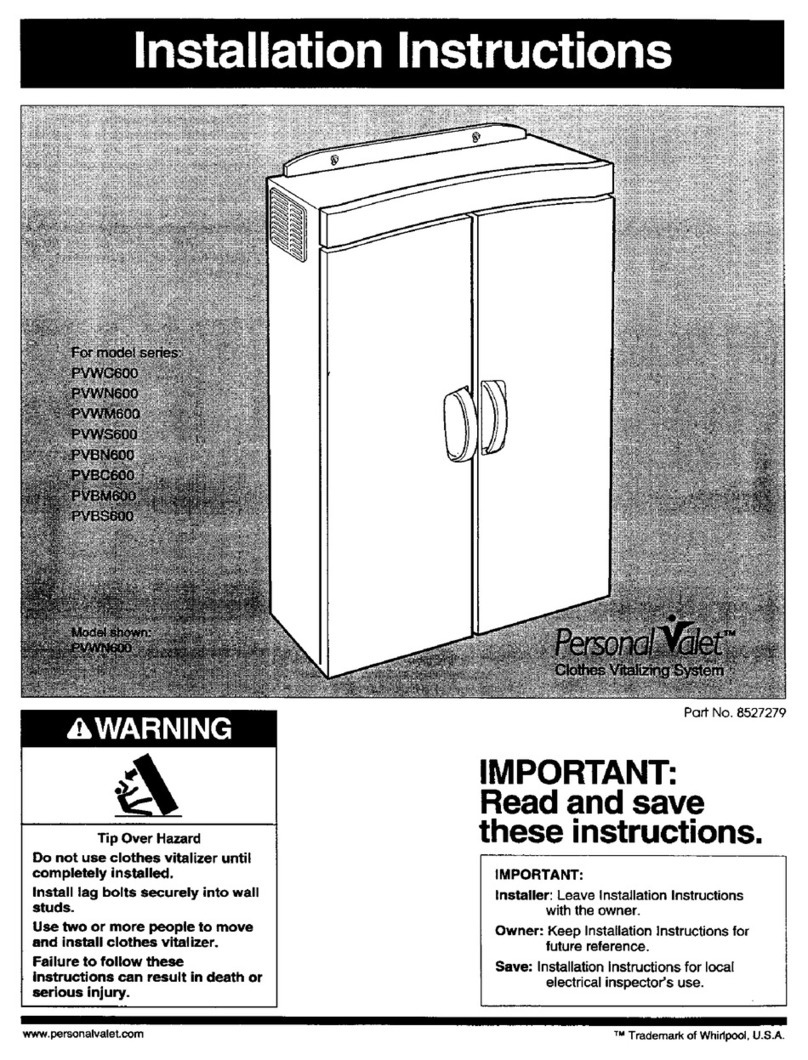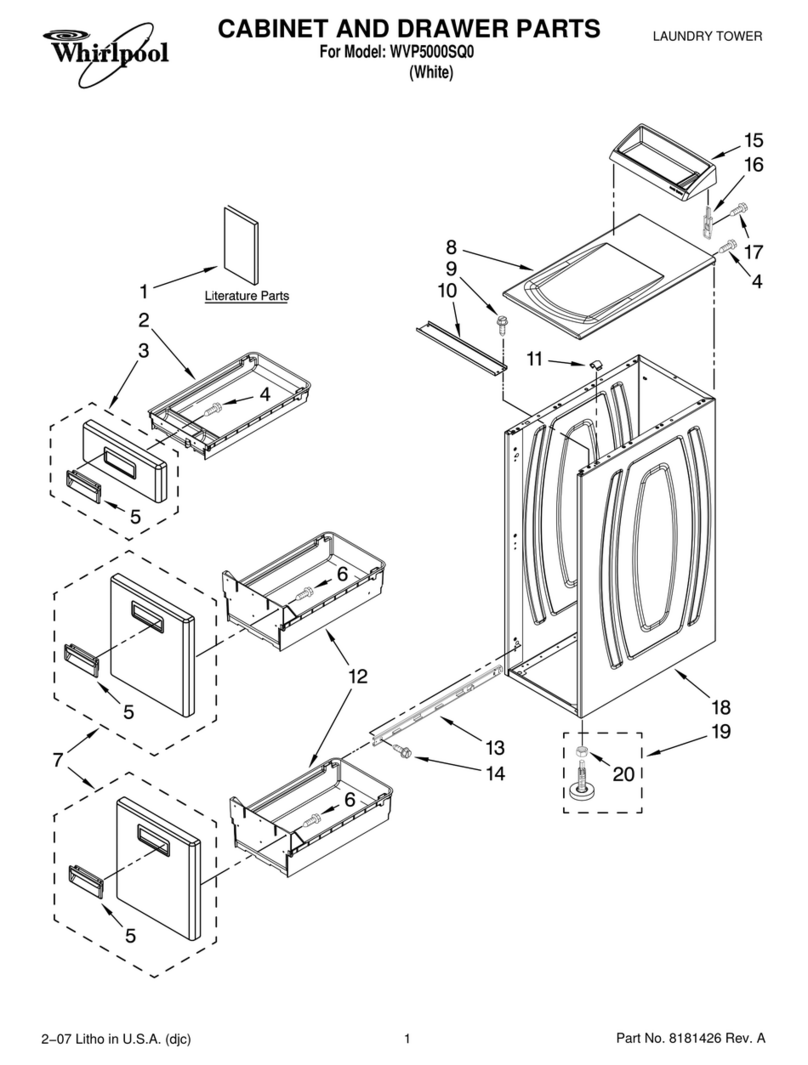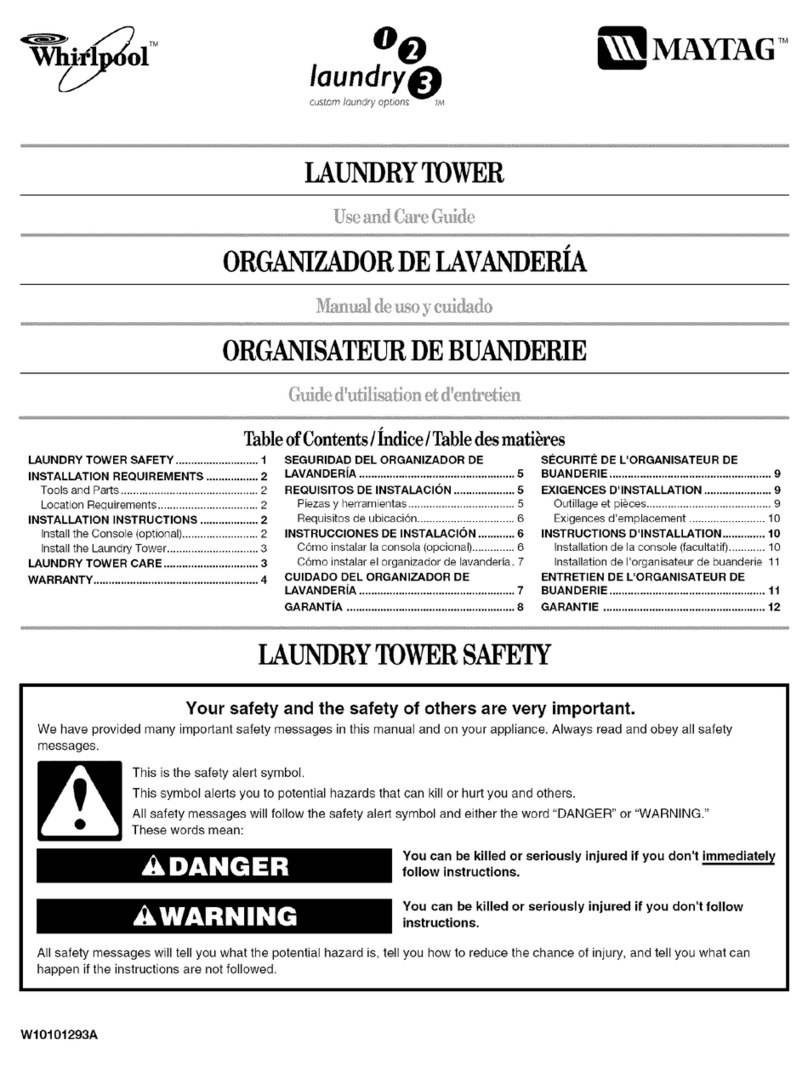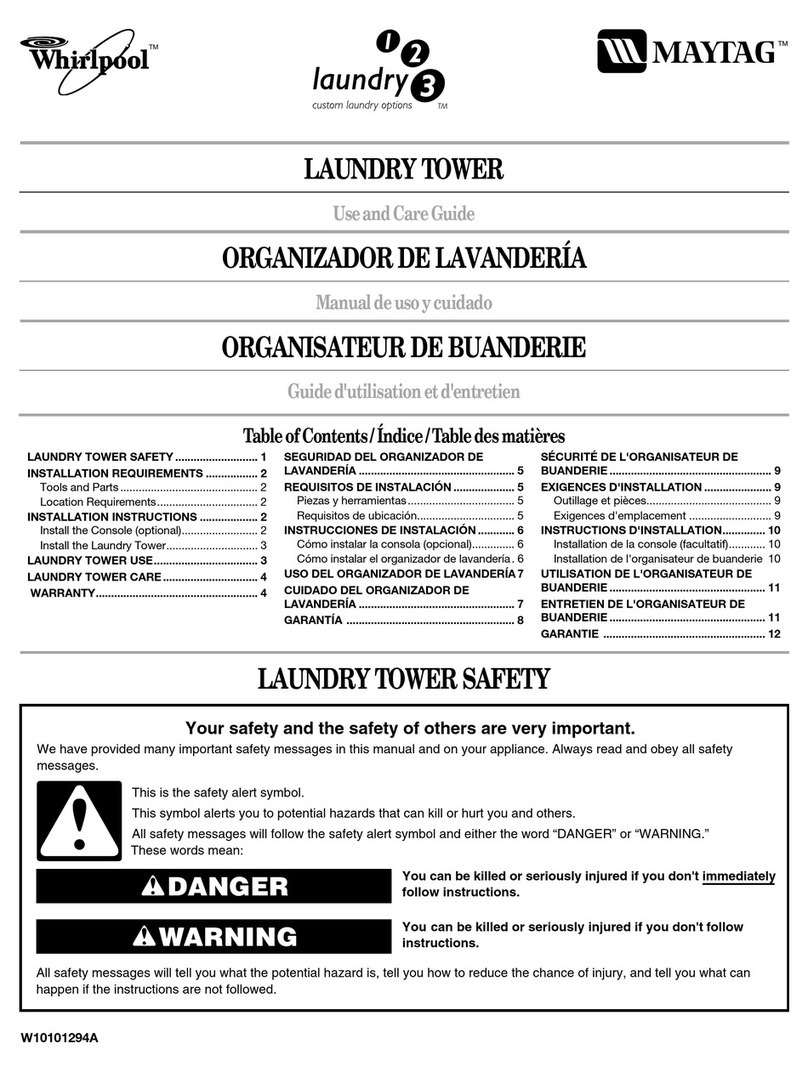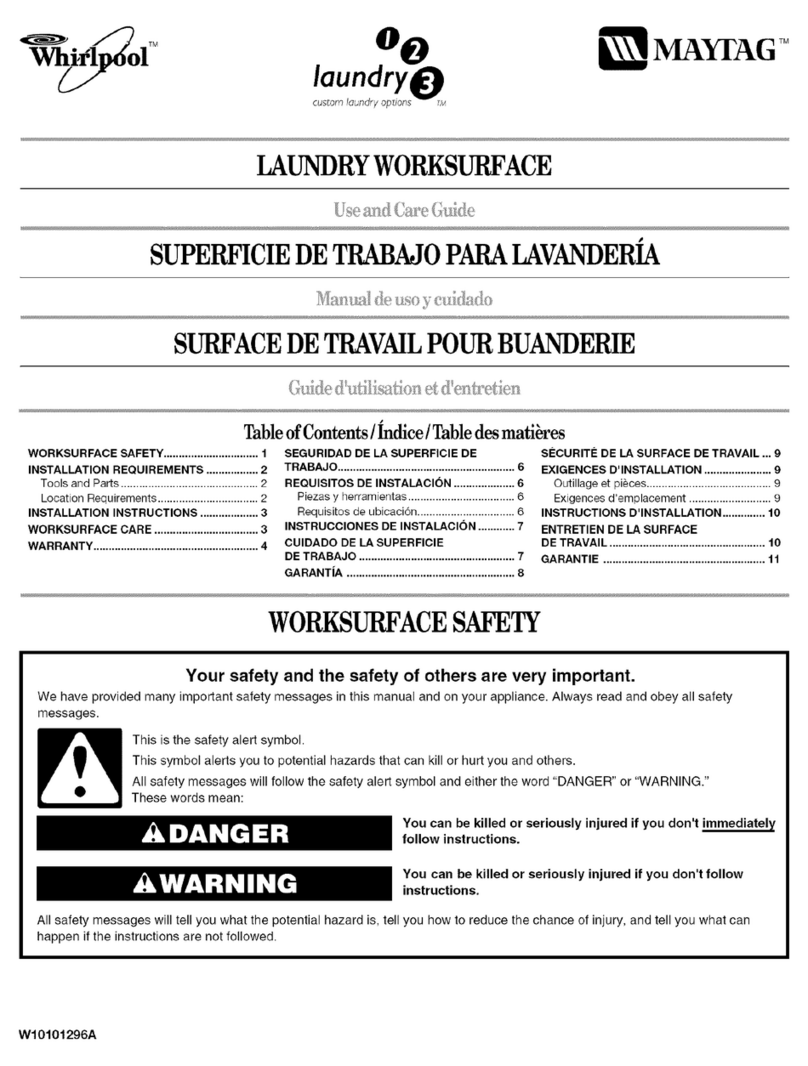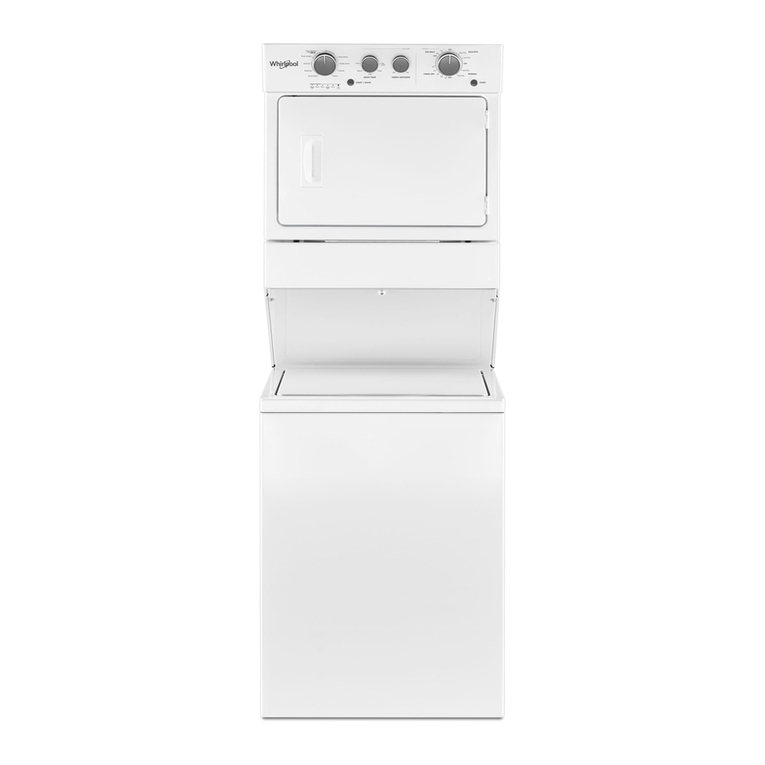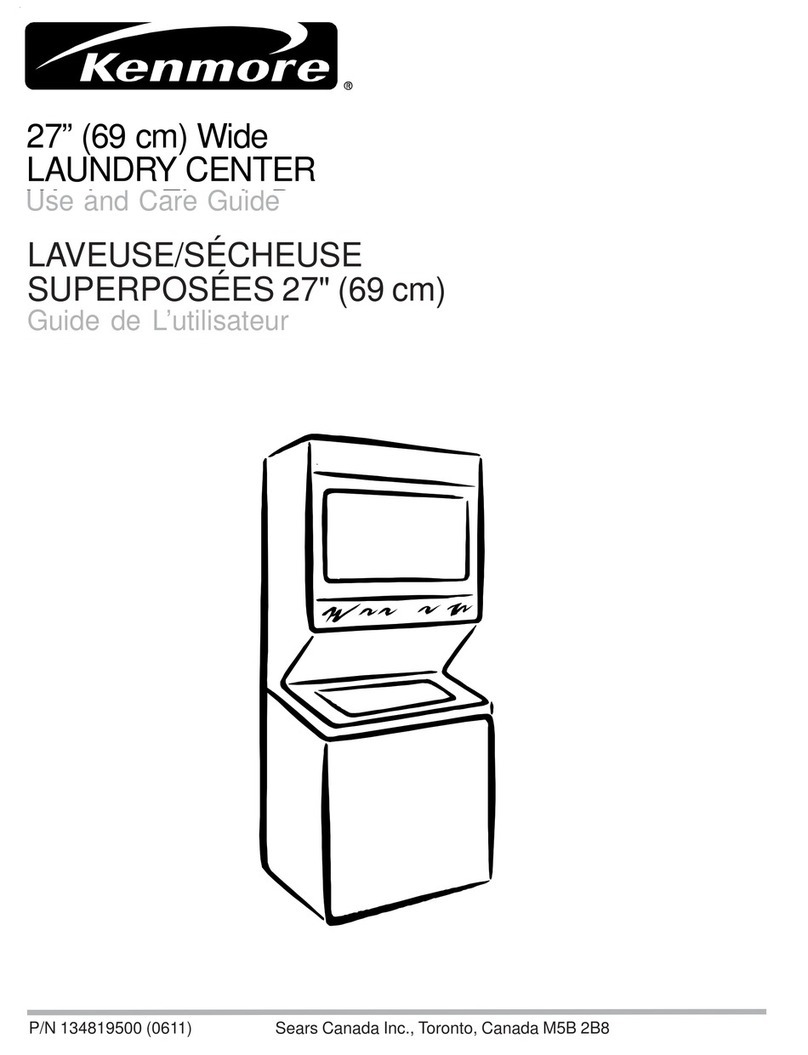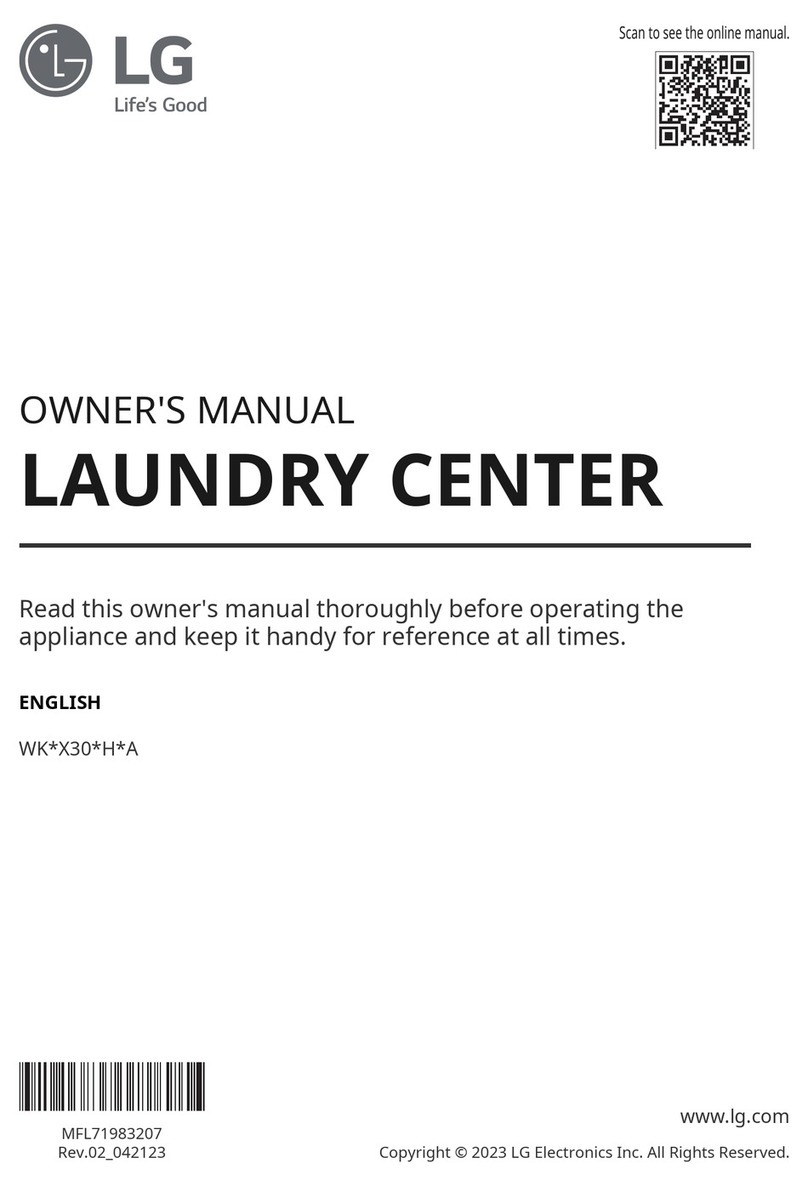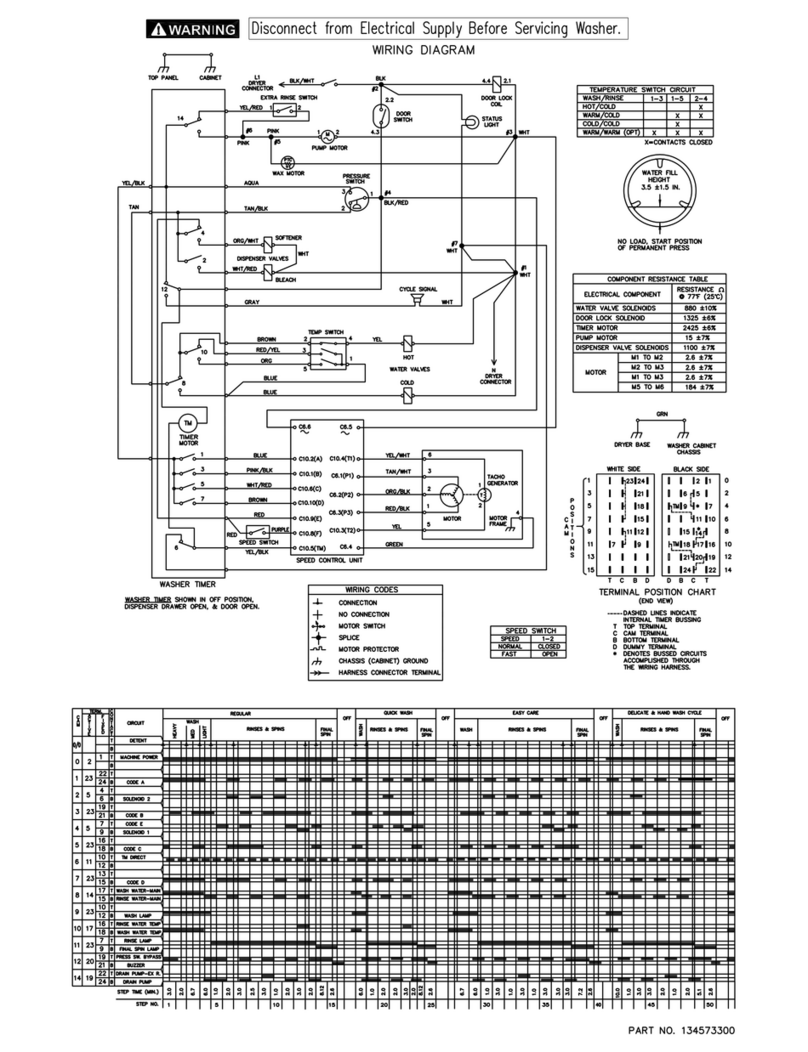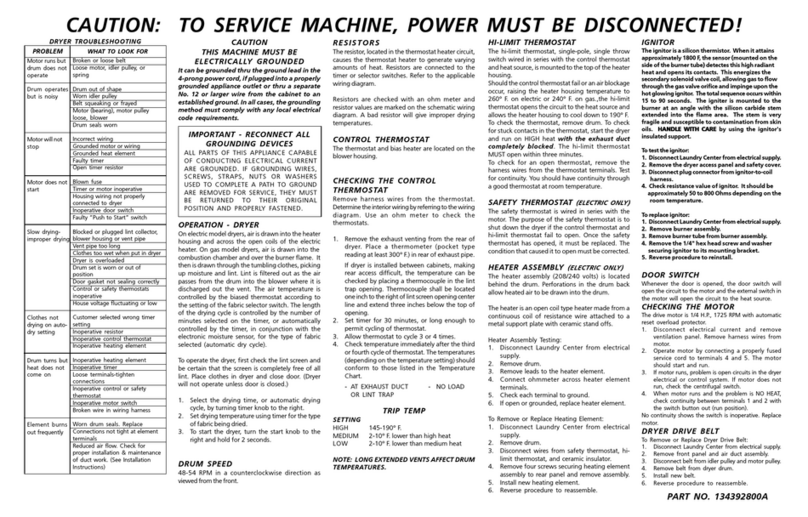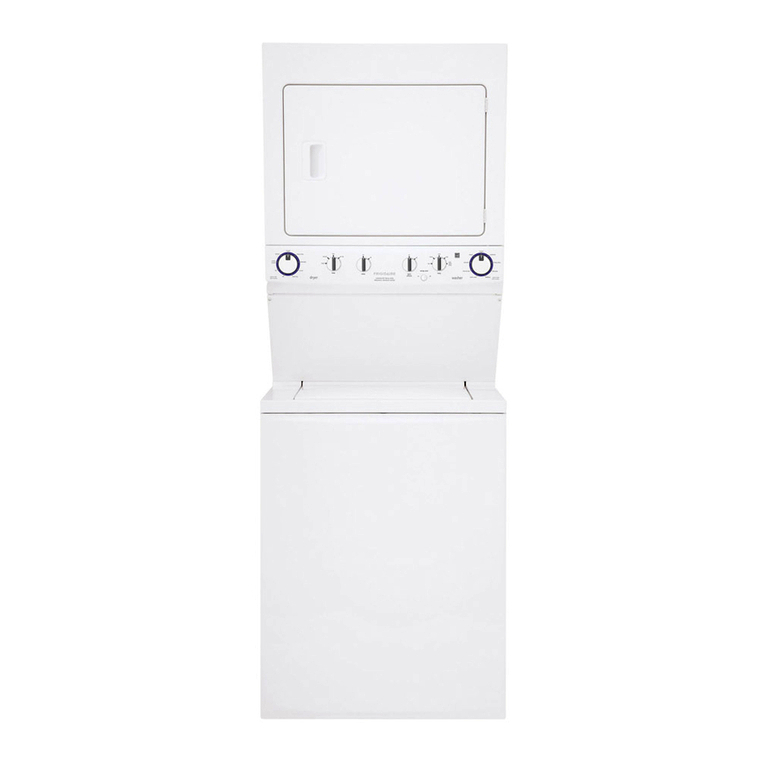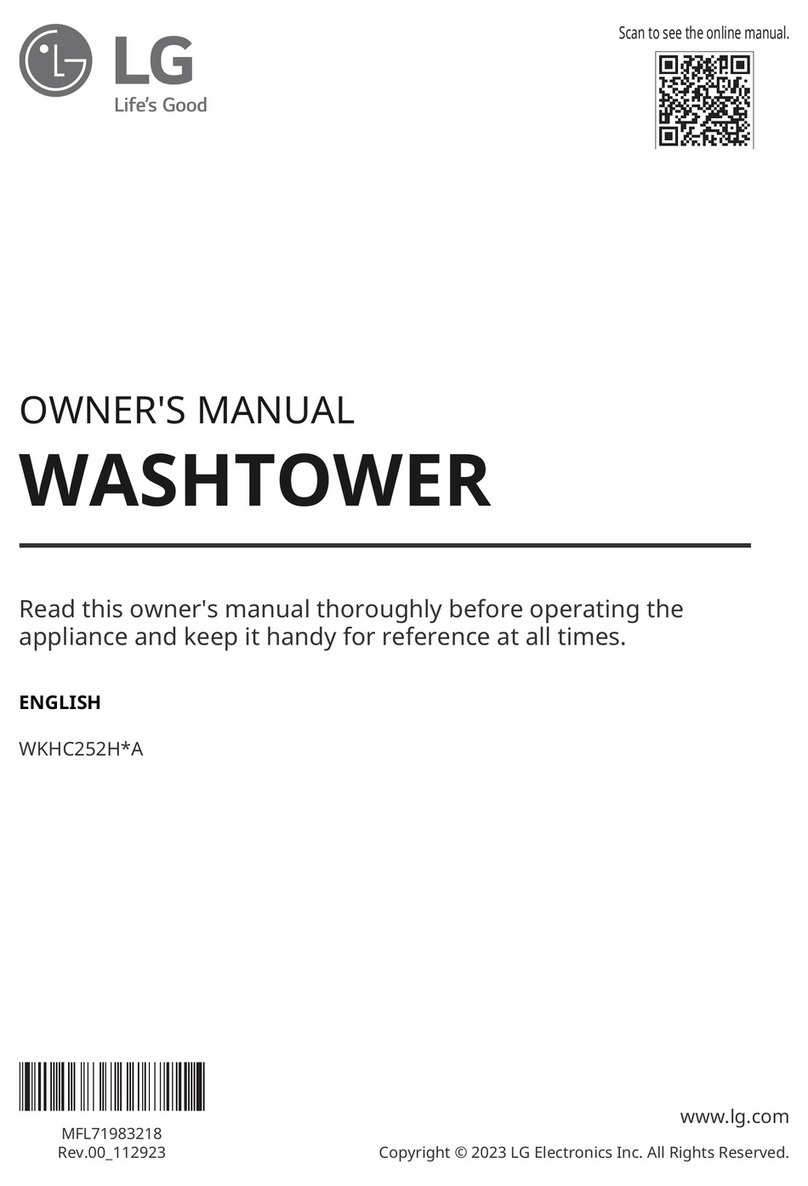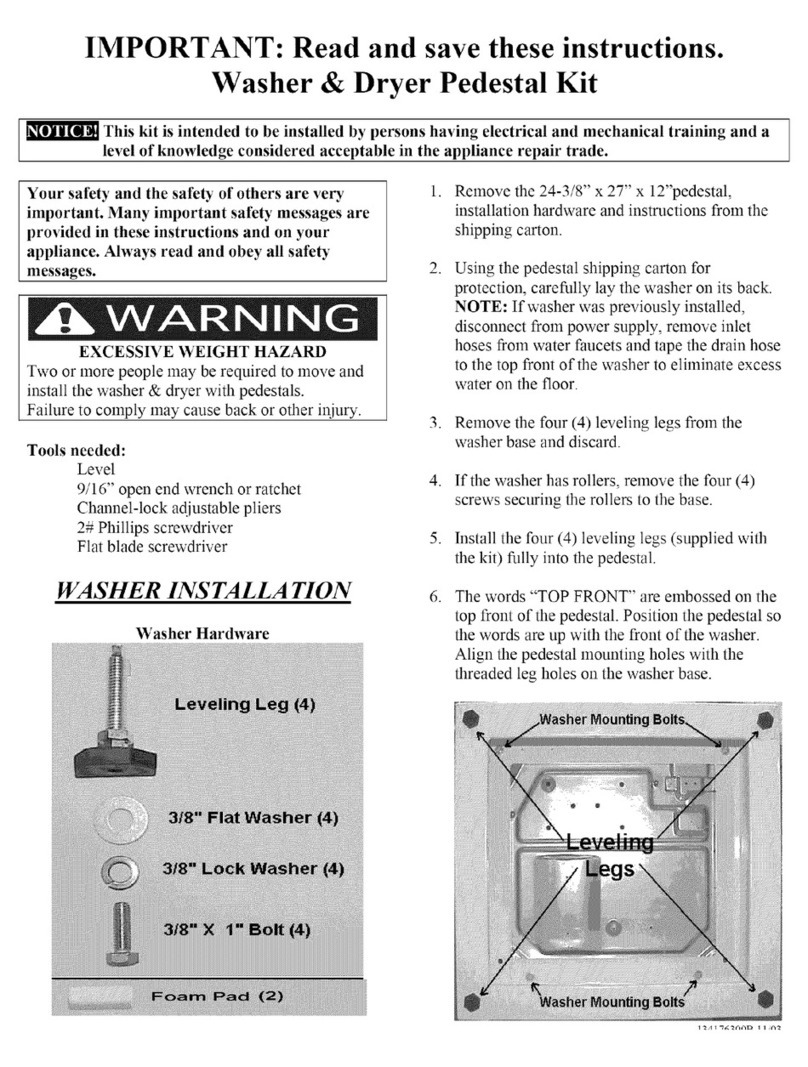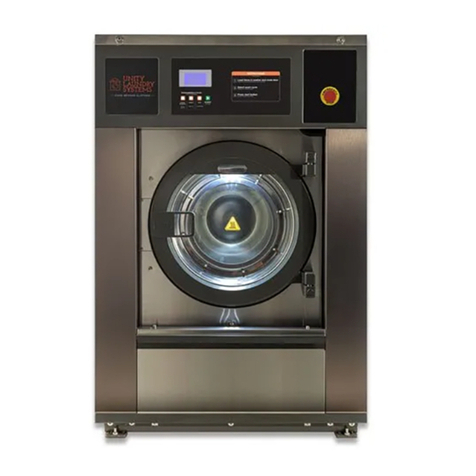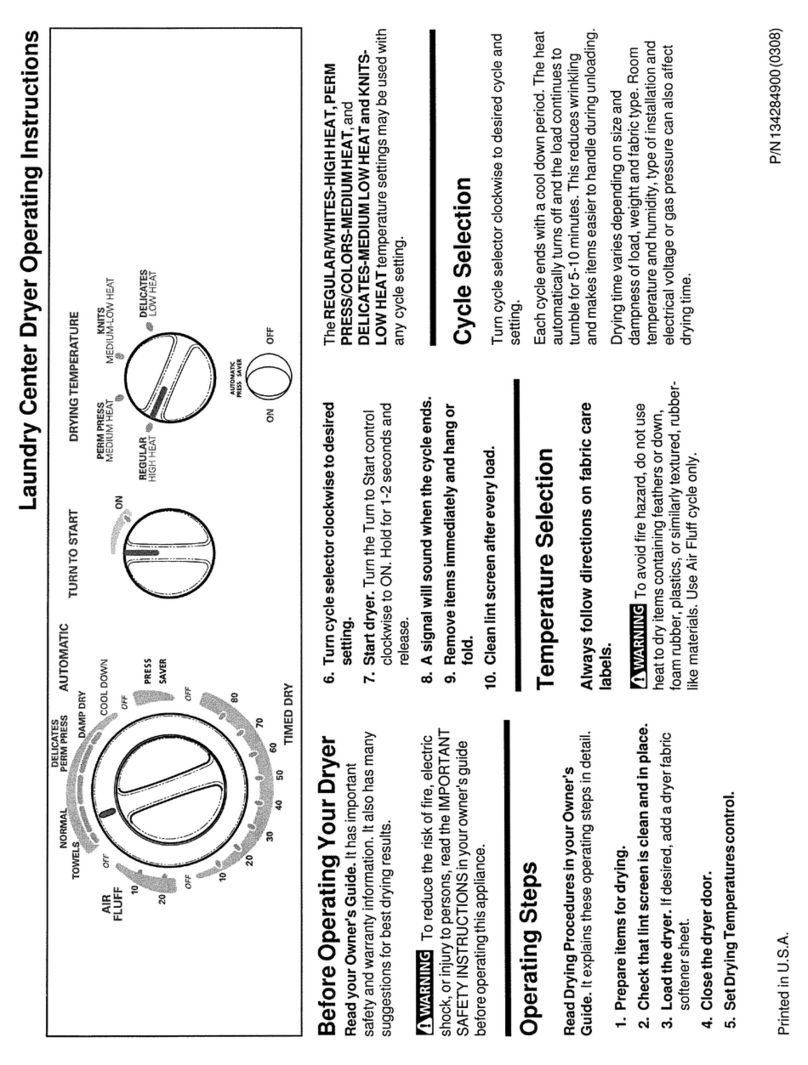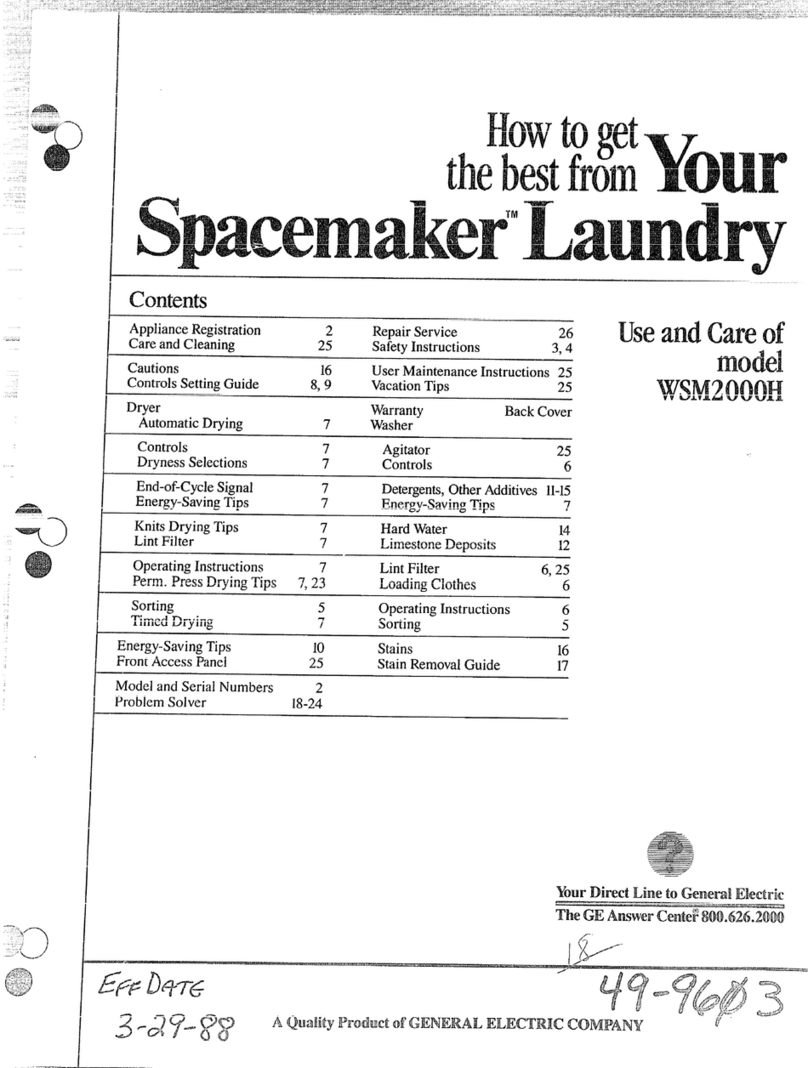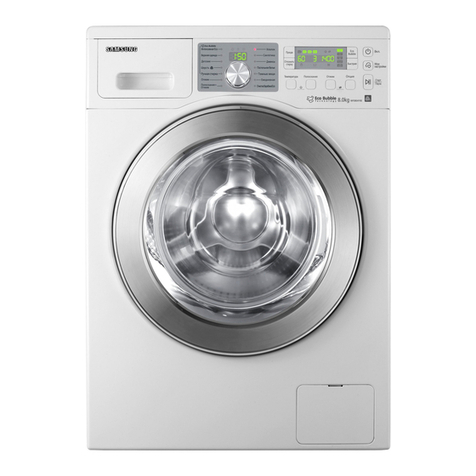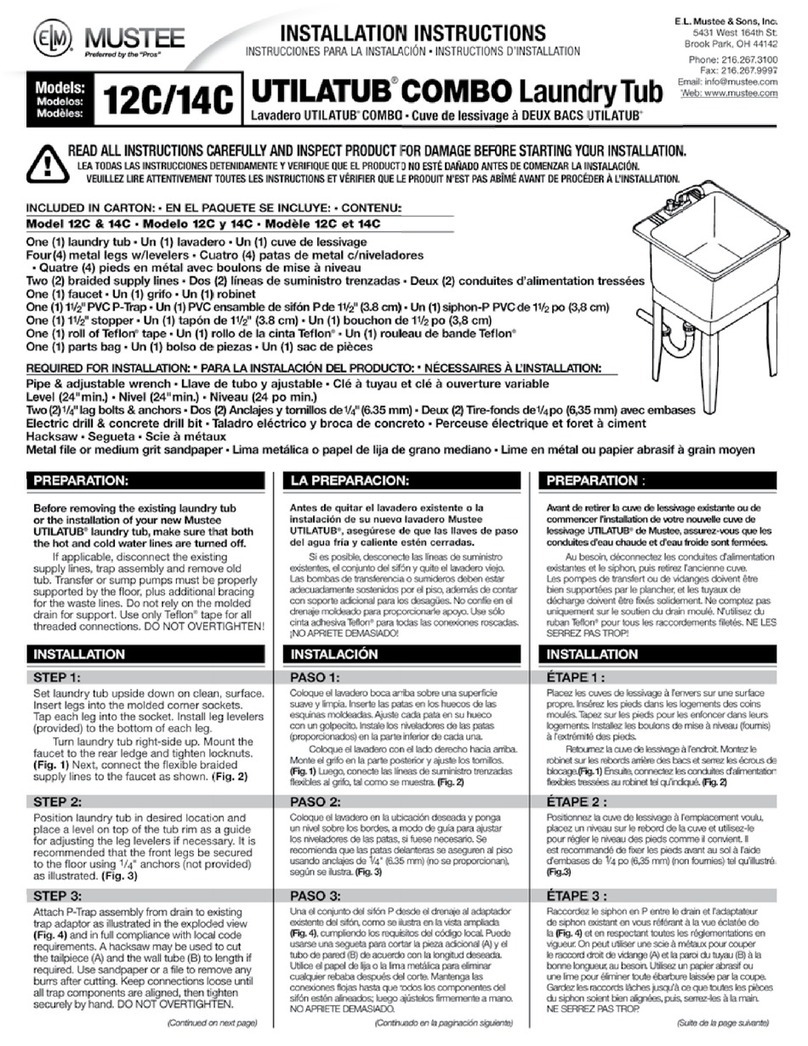
1-6 n
27” Stacked Laundry Center
GENERAL INFORMATION
Using the Washer
Add Laundry Products
11
■Empty pockets. Loose change, buttons, or any small object
can pass under the agitator and become trapped, causing
unexpected sounds.
■Sort items by recommended cycle, water temperature,
and colorfastness.
■Separate heavily soiled items from lightly soiled.
■Separate delicate items from sturdy fabrics.
■Do not dry garments if stains remain after washing, because
heat can set stains into fabric.
■Treat stains promptly.
■Close zippers, fasten hooks, tie strings and sashes, and
remove non-washable trim and ornaments.
■Mend rips and tears to avoid further damage to items
during washing.
Helpful Tips:
■When washing waterproof or water-resistant items, load evenly.
■Use mesh garment bags to help avoid tangling when washing
delicate or small items.
■Turn knits inside out to avoid pilling. Separate lint-takers from
lint-givers. Synthetics, knits, and corduroy fabrics will pick up
lint from towels, rugs, and chenille fabrics.
NOTE: Always read and follow fabric care label instructions to
avoid damage to your garments.
1. Sort and prepare your laundry
USING YOUR WASHER
Add a measured amount of HE
detergent or single-dose laundry
packet into the basket.
If using Oxi-type boosters, color-safe
bleach, or fabric softener crystals, add
to the bottom of the washer basket before adding clothes.
IMPORTANT: Use only High Efciency detergents. The package
will be marked “HE” or “High Efciency.” Using non-HE
detergent will likely result in longer cycle times and reduced
rinsing performance. It may also result in component malfunction
and, over time, buildup of mold or mildew. HE detergents should
be low-sudsing and quick-dispersing to produce the right
amount of suds for the best performance. They should hold soil
in suspension so it is not redeposited onto clean clothes. Not all
detergents labeled as High Efciency are identical in formulation
and their ability to reduce suds. For example, natural, organic,
or homemade HE detergents may generate a high level of suds.
NOTE: Follow the manufacturer’s instructions to determine the
amount of laundry products to use.
2. Add laundry products
Figure X
Add a measured amount of HE detergent or single-dose
laundry packet into the basket.
If using Oxi-type boosters, color-safe bleach, or fabric soener
crystals, add to the boom of the washer basket before adding
clothes.
IMPORTANT: Use only High Eciency detergents. The
package will be marked “HE” or “High Eciency.” Using
non-HE detergent will likely result in longer cycle mes and
reduced rinsing performance. It may also result in component
malfuncon and, over me, buildup of mold or mildew. HE
detergents should be low-sudsing and quick-dispersing to
produce the right amount of suds for the best performance.
They should hold soil in suspension so it is not redeposited
onto clean clothes. Not all detergents labeled as High
Eciency are idencal in formulaon and their ability to
reduce suds. For example, natural, organic, or homemade HE
detergents may generate a high level of suds.
NOTE: Follow the manufacturer’s instrucons to determine
the amount of laundry products to use.
Add Liquid Chlorine Bleach to Dispenser
Do not overll, dilute, or use more than 1 cup (236 mL). Do
not use color-safe bleach or Oxi products in the same cycle
with liquid chlorine bleach.
12
5. Add fabric softener to dispenser
Pour a measured amount of liquid fabric
softener into dispenser; always follow
manufacturer’s directions for correct amount
of fabric softener based on your load size.
Dilute liquid fabric softener by lling the dispenser with warm
water until liquid reaches the underside of the rim. See max ll
line arrows. Do not overll.
Adding Liquid Fabric Softener Manually to Wash Load
During the nal rinse, wait until the washer has completed lling
and press the START/PAUSE button to pause the washer. Lift
the lid and add the measured recommended amount of liquid
fabric softener. Do not allow liquid fabric softener to spill, splash,
drip, or run into the basket or on load. Do not use more than
the recommended amount. Close the lid and press the START/
PAUSE button again to start the washer.
Do not overll, dilute, or use more than 1 cup (236 mL).
Do not use color-safe bleach or Oxi products in the same
cycle with liquid chlorine bleach.
Load garments in loose heaps evenly around basket wall.
For best results, do not pack the load tightly. Do not wrap large
items such as sheets around the agitator; load them in loose
piles around the sides of the basket. Try mixing different-sized
items to reduce tangling.
3. Load laundry into washer
IMPORTANT: Do not tightly pack or force items into washer.
Items need to move freely for best cleaning and to reduce
wrinkling and tangling.
Turn cycle knob to choose your wash cycle. For more
information, see “Washer Cycle Guide.”
6. Select cycle
4.
Add liquid chlorine bleach
to dispenser
MAX FILL
Liquid
Chlorine Bleach
Figure X
Add Fabric Softener to Dispenser
12
5. Add fabric softener to dispenser
Pour a measured amount of liquid fabric
softener into dispenser; always follow
manufacturer’s directions for correct amount
of fabric softener based on your load size.
Dilute liquid fabric softener by lling the dispenser with warm
water until liquid reaches the underside of the rim. See max ll
line arrows. Do not overll.
Adding Liquid Fabric Softener Manually to Wash Load
During the nal rinse, wait until the washer has completed lling
and press the START/PAUSE button to pause the washer. Lift
the lid and add the measured recommended amount of liquid
fabric softener. Do not allow liquid fabric softener to spill, splash,
drip, or run into the basket or on load. Do not use more than
the recommended amount. Close the lid and press the START/
PAUSE button again to start the washer.
Do not overll, dilute, or use more than 1 cup (236 mL).
Do not use color-safe bleach or Oxi products in the same
cycle with liquid chlorine bleach.
Load garments in loose heaps evenly around basket wall.
For best results, do not pack the load tightly. Do not wrap large
items such as sheets around the agitator; load them in loose
piles around the sides of the basket. Try mixing different-sized
items to reduce tangling.
3. Load laundry into washer
IMPORTANT: Do not tightly pack or force items into washer.
Items need to move freely for best cleaning and to reduce
wrinkling and tangling.
Turn cycle knob to choose your wash cycle. For more
information, see “Washer Cycle Guide.”
6. Select cycle
4.
Add liquid chlorine bleach
to dispenser
MAX FILL
Liquid
Chlorine Bleach
12
5. Add fabric softener to dispenser
Pour a measured amount of liquid fabric
softener into dispenser; always follow
manufacturer’s directions for correct amount
of fabric softener based on your load size.
Dilute liquid fabric softener by lling the dispenser with warm
water until liquid reaches the underside of the rim. See max ll
line arrows. Do not overll.
Adding Liquid Fabric Softener Manually to Wash Load
During the nal rinse, wait until the washer has completed lling
and press the START/PAUSE button to pause the washer. Lift
the lid and add the measured recommended amount of liquid
fabric softener. Do not allow liquid fabric softener to spill, splash,
drip, or run into the basket or on load. Do not use more than
the recommended amount. Close the lid and press the START/
PAUSE button again to start the washer.
Do not overll, dilute, or use more than 1 cup (236 mL).
Do not use color-safe bleach or Oxi products in the same
cycle with liquid chlorine bleach.
Load garments in loose heaps evenly around basket wall.
For best results, do not pack the load tightly. Do not wrap large
items such as sheets around the agitator; load them in loose
piles around the sides of the basket. Try mixing different-sized
items to reduce tangling.
3. Load laundry into washer
IMPORTANT: Do not tightly pack or force items into washer.
Items need to move freely for best cleaning and to reduce
wrinkling and tangling.
Turn cycle knob to choose your wash cycle. For more
information, see “Washer Cycle Guide.”
6. Select cycle
4.
Add liquid chlorine bleach
to dispenser
MAX FILL
Pour a measured amount of liquid fabric soener into
dispenser; always follow manufacturer’s direcons for correct
amount of fabric soener based on your load size.
Dilute liquid fabric soener by lling the dispenser with warm
water unl liquid reaches the underside of the rim. See max ll
line arrows. Do not overll.
Adding Liquid Fabric Soener Manually to Wash Load
During the nal rinse, wait unl the washer has completed
lling and press the START/PAUSE buon to pause the washer.
Li the lid and add the measured recommended amount of
liquid fabric soener. Do not allow liquid fabric soener to
spill, splash, drip, or run into the basket or on load. Do not use
more than the recommended amount. Close the lid and press
the START/ PAUSE buon again to start the washer.
Figure X
